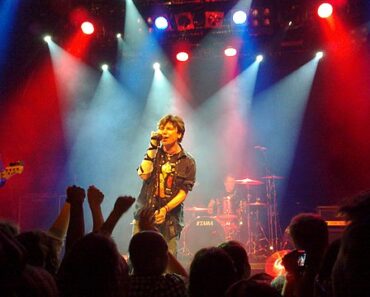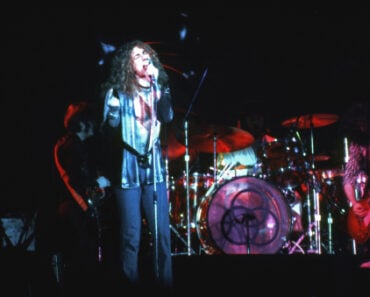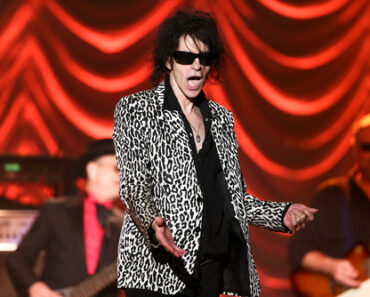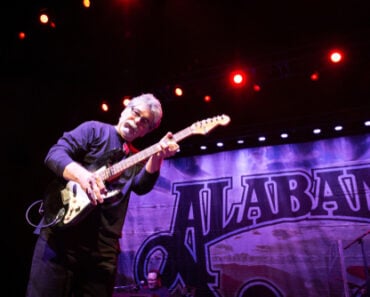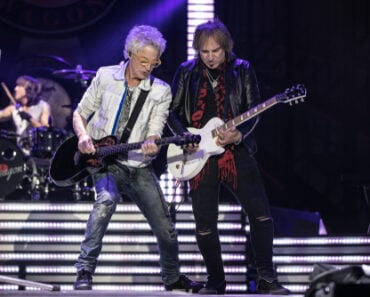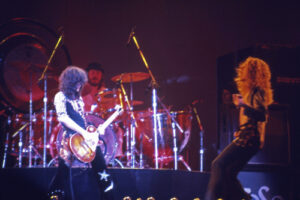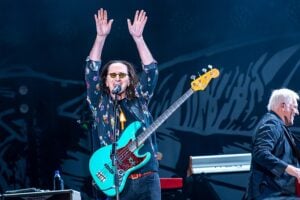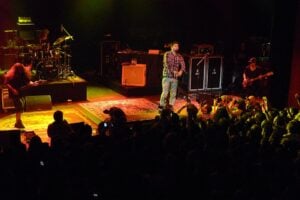
Feature Photo: Northfoto / Shutterstock.com
The Complete Guide to Grateful Dead Guitarists
The Grateful Dead emerged from the San Francisco Bay Area in 1965 as one of rock music’s most innovative and enduring acts, with guitar serving as the cornerstone of their revolutionary sound. Originally forming from the electric transformation of the jug band Mother McCree’s Uptown Jug Champions, the group evolved through their brief incarnation as the Warlocks before settling on the iconic name that would define American psychedelic and jam band music for three decades. The interplay between lead and rhythm guitar became the foundation for their legendary improvisational jams that could stretch for hours, creating a unique musical framework that blended rock, folk, bluegrass, blues, jazz, country, and psychedelia into something entirely new.
Throughout their 30-year career from 1965 to 1995, the Grateful Dead maintained a remarkably stable guitar lineup, with Jerry Garcia’s exploratory lead work and Bob Weir’s revolutionary rhythm approach forming an unprecedented musical partnership. Garcia’s melodic, jazz-influenced improvisations provided the band’s spiritual and musical leadership, while Weir developed one of rock’s most distinctive rhythm guitar styles, often playing complex chord inversions and counterpoint patterns that complemented rather than simply supported the lead guitar. This guitar-centric approach transformed live rock performance from structured song delivery to spontaneous musical exploration, establishing the template for the entire jam band movement and influencing countless musicians across genres.
The role of guitar in the Grateful Dead’s music extended far beyond traditional rock conventions, serving as both melodic anchor and exploratory vehicle for their extended musical journeys. Garcia’s warm, melodic playing style emphasized touch sensitivity and constant tonal variation through custom instruments built by luthier Doug Irwin, while Weir’s McCoy Tyner-influenced approach challenged rhythm guitar conventions by emphasizing counterpoint and harmonic interaction. Together, they created a musical telepathy that allowed for spontaneous direction changes and complementary improvisational frameworks during live performance, making each of their over 2,200 concerts a unique musical experience.
Following Jerry Garcia’s death in 1995, the surviving members formally disbanded the Grateful Dead, but various reunion projects emerged featuring accomplished guitarists who brought their own interpretations while honoring the improvisational spirit that made the Dead’s guitar work legendary. These post-Garcia incarnations, including The Other Ones, The Dead, Furthur, and Dead & Company, have introduced the band’s music to new generations while maintaining the guitar-driven improvisational approach that defined their original sound. From the technically precise recreations of tribute band veterans to the mainstream appeal of contemporary artists, these musicians have ensured that the Grateful Dead’s guitar legacy continues to evolve and inspire.
The complete story of Grateful Dead guitarists encompasses not only the core members who defined the band’s sound but also the diverse array of musicians who have carried their musical vision forward into the 21st century, creating an unbroken chain of guitar-driven exploration that spans nearly six decades of American music history.
Jerry Garcia
Jerome John “Jerry” Garcia (1942-1995) emerged as one of rock music’s most innovative and influential guitarists through his three-decade tenure as the Grateful Dead’s lead guitarist and primary musical architect. Born into a musical San Francisco family, Garcia’s early life was marked by tragedy—losing his father in a drowning accident at age four and most of his right middle finger in a wood-chopping accident the same year. Despite these setbacks, he developed into a virtuosic multi-instrumentalist, beginning with piano lessons before discovering the banjo and eventually the electric guitar at age 15 after hearing Chuck Berry. His musical foundation was built on diverse influences including bluegrass legends Bill Monroe and Doc Watson, jazz saxophonist John Coltrane, blues masters like Freddie King and Chuck Berry, and country pioneers, creating the eclectic musical vocabulary that would define the Grateful Dead’s sound.
Garcia’s revolutionary guitar approach synthesized an unprecedented range of American musical traditions—rock, blues, country, folk, bluegrass, jazz, and psychedelia—into a distinctive improvisational style that prioritized melodic storytelling over technical showmanship. His technique featured extensive use of chromatic passing tones, chord-tone encirclement borrowed from bebop jazz, and rhythmic triplets delivered through his custom Doug Irwin guitars (Wolf, Tiger, and Rosebud). These instruments featured innovative electronics including onboard preamps, effects loops, coil-tap switches, and MIDI capabilities that allowed Garcia to access an extraordinary tonal palette. His playing style emphasized touch sensitivity, constant volume and tone adjustments during solos, varied right-hand positioning for timbral changes, and extensive vibrato on sustained notes, creating what he called “twelve discrete possible voices” through his instruments.
As the Grateful Dead’s musical leader, Garcia composed iconic songs including “Dark Star,” “Franklin’s Tower,” “Scarlet Begonias,” and “Ripple” (with lyricist Robert Hunter), while his guitar work defined legendary performances such as the 23-minute “Dark Star” from Live/Dead (1969) and the Cornell 5/8/77 “Scarlet Begonias > Fire on the Mountain.” His improvisational philosophy—described as “making it up as I go along”—transformed live rock performance from structured song delivery to spontaneous musical exploration, establishing the template for the jam band movement. With over 15,000 hours of recorded music across 2,200+ Grateful Dead concerts, he became “the most recorded guitarist in history” according to fellow musician Henry Kaiser. Rolling Stone ranked him 13th among the “100 Greatest Guitarists of All Time” (2003), while his musical legacy continues to influence generations of guitarists from Trey Anastasio to John Mayer, ensuring the continuation of Garcia’s revolutionary vision of guitar as a vehicle for endless musical discovery and communal transcendence.
Bob Weir
Bob Weir’s role as the Grateful Dead’s rhythm guitarist represents one of rock music’s most revolutionary approaches to the instrument, fundamentally redefining what rhythm guitar could accomplish within a band context. Born Robert Hall Weir on October 16, 1947, and adopted by affluent parents in Atherton, California, Weir struggled academically due to undiagnosed dyslexia but found his calling when he began playing guitar at age 13. His life changed dramatically on New Year’s Eve 1963, when the 16-year-old Weir encountered 21-year-old Jerry Garcia at Dana Morgan’s Music Store in Palo Alto, leading to an all-night jam session that would birth one of rock’s most enduring partnerships. Though initially the youngest and least experienced member when the Grateful Dead formed in 1965, Weir’s musical development accelerated dramatically after a crisis in 1968 when Garcia and Phil Lesh briefly dismissed him for not “pulling his weight musically.”
This setback became a catalyst for growth, prompting Weir to develop his distinctive approach by studying jazz piano, particularly McCoy Tyner’s work with the John Coltrane Quartet. “I learned by trying to imitate a piano, specifically the work of McCoy Tyner,” Weir explained, describing how he absorbed Tyner’s counterpoint techniques that provided harmonic support underneath Coltrane’s improvisations. Weir’s musical innovations fundamentally challenged traditional rhythm guitar conventions, creating a style that emphasized counterpoint, alternative chord voicings, and dynamic harmonic interaction rather than repetitive strumming patterns. His approach was perfectly suited to the Grateful Dead’s improvisational ethos, as he developed an intuitive musical telepathy with Garcia that allowed him to anticipate where solos were heading and provide complementary harmonic frameworks.
Beyond his instrumental contributions, Weir served as a crucial songwriting voice and vocalist throughout the Grateful Dead’s 30-year career, collaborating initially with Robert Hunter on classics like “Sugar Magnolia” and “Truckin'” before finding his primary lyrical partner in childhood friend John Perry Barlow. Together, Weir and Barlow created some of the band’s most enduring compositions, including “Cassidy,” “Playing in the Band,” “The Other One,” and “Black-Throated Wind,” often featuring complex time signatures and sophisticated harmonic structures that reflected Weir’s jazz influences. His vocal contributions were equally significant, as he sang lead on approximately half of the Dead’s repertoire, bringing a distinctive timbre to cowboy songs, rock anthems, and experimental compositions alike. Weir’s legacy extends far beyond his instrumental technique; his musical philosophy of serving the song while maintaining creative independence established a template for rhythm guitarists seeking to transcend traditional limitations, proving that supporting roles could be equally innovative and essential to a band’s artistic identity.
Ron “Pigpen” McKernan
Ron “Pigpen” McKernan (1945-1973) served as one of the Grateful Dead’s founding members and, while primarily known as a keyboardist and harmonica player, occasionally contributed guitar during the band’s formative years. Born into a blues-loving family in San Bruno, California, McKernan absorbed the music of Lightnin’ Hopkins, Jimmy Reed, Ray Charles, and other blues and R&B masters through his father’s extensive record collection and radio DJ work. His blues authenticity and commanding stage presence made him the band’s original front man and the driving force behind their decision to “go electric” in 1965, transforming them from an acoustic jug band into the psychedelic pioneers they would become. McKernan’s musical contributions extended beyond keyboards and harmonica to occasional guitar work, particularly during the band’s early experimental period when instrumental roles were more fluid.
McKerran’s influence on the Grateful Dead’s sound cannot be overstated, as his deep blues knowledge provided the foundation upon which Garcia and Weir built their more experimental approaches. His gritty vocals on songs like “Turn on Your Love Light,” “Good Morning Little Schoolgirl,” and “Big Boss Man” showcased a different side of the Dead’s musical personality, grounding their psychedelic explorations in authentic American blues tradition. His decline due to alcoholism began affecting his performances by 1970, leading to reduced participation in the band’s activities and ultimately his departure in 1972. McKernan died of a gastrointestinal hemorrhage in March 1973, just months after the release of the band’s blues-influenced “Europe ’72” album that featured some of his final recordings. Though his guitar contributions were limited compared to his keyboard and vocal work, McKernan’s role in shaping the band’s early sound and blues foundation influenced how all subsequent Dead guitarists approached the intersection of traditional American music and psychedelic experimentation.
Mark Karan
Mark Karan emerged as one of the most important guitarists in the post-Jerry Garcia era, bringing a raw, intuitive approach that honored the Dead’s improvisational spirit while establishing his own musical identity. Born January 13, 1955, in San Francisco, Karan worked extensively as a session musician and touring guitarist for major artists including Dave Mason, Delaney Bramlett, The Rembrandts, Paul Carrack, Huey Lewis, Jesse Colin Young, and Sophie B. Hawkins before joining the Grateful Dead extended family. From 1986-1989, he was guitarist and co-producer for the band Slings & Arrows, developing the blues-based psychedelic style that would make him an ideal fit for Dead-related projects. Remarkably, Karan was actually photographed as a young fan on the “Live Dead” album cover, having attended nearly 50 Grateful Dead shows in his youth, creating a full-circle connection to the music he would later help perpetuate.
Co-selected along with Steve Kimock in 1998 to fill the lead guitar position in The Other Ones, Karan later anchored the lead guitar slot in Bob Weir’s RatDog from 1998-2013, playing hundreds of shows annually and becoming one of the most active musicians in the Dead universe. His musical style was characterized by a more raw and intuitive playing approach compared to other post-Jerry guitarists, emphasizing blues-based improvisation with psychedelic elements that meshed naturally with the Dead’s established framework. Unlike some of his contemporaries who focused on replicating Garcia’s exact style, Karan brought his own musical personality while respecting the improvisational traditions that defined the band’s approach to live performance.
Karan’s resilience was tested in 2007 when he was diagnosed with throat cancer, during which Steve Kimock filled in for him on RatDog’s summer tour. He returned in March 2008 in complete remission and continued his prolific touring schedule until 2013. His 2009 solo album “Walk Through the Fire” featured collaborations with Delaney Bramlett, Billy Payne, Mike Finnigan, and The Persuasions, showcasing his ability to work across multiple genres while maintaining the collaborative spirit that defined his work with Dead-related projects. Karan’s contributions to the post-Garcia era helped establish that the Dead’s musical framework was robust enough to support different interpretations while maintaining the essential improvisational character that made each performance unique.
Steve Kimock
Steve Kimock has been one of the most respected and versatile guitarists in the Grateful Dead extended universe, earning recognition from Jerry Garcia himself as one of his favorite contemporary players. Born October 5, 1955, in Bethlehem, Pennsylvania, Kimock was a member of San Francisco Bay Area bands Zero and KVHW before his extensive work with Dead-related projects began. Jerry Garcia specifically cited Kimock, along with Frank Gambale and Michael Hedges, as one of his favorite guitar players during the later part of his life, a endorsement that carried tremendous weight within the Dead community and helped establish Kimock’s credibility as a worthy successor to Garcia’s improvisational approach.
Kimock’s involvement with Grateful Dead-related music began earlier than most post-Jerry guitarists, having played with Keith and Donna Godchaux’s Heart of Gold Band (1979-80) and Bob Weir’s Kingfish (1986) during the original band’s active years. His most significant contributions came in the post-Garcia era, playing with Phil Lesh and Friends (1998-99), The Other Ones (1998-2000), and serving as a member of the Rhythm Devils in 2006 alongside Dead drummers Bill Kreutzmann and Mickey Hart. His fluid improvisation and technical precision drew natural comparisons to Jerry Garcia, making him a perfect fit for Dead-related music while maintaining his own four-decade career of psychedelic exploration across electric, acoustic, lap steel, and pedal steel guitars.
Known for a more trained and technical approach compared to the rawer style of Mark Karan, Kimock brought sophisticated harmonic knowledge and exceptional improvisational skills that honored Garcia’s legacy while contributing his own musical perspective. His ability to seamlessly move between different guitar styles and his deep understanding of the Dead’s musical framework made him an invaluable collaborator for surviving band members seeking to continue their musical journey. Kimock filled in for Mark Karan in RatDog in 2007 during Karan’s cancer treatment and rejoined the band in 2013, demonstrating his ongoing commitment to the Dead’s musical community. His recent involvement with Live Dead & Brothers for their 2025 spring tour shows that his contributions to the Dead’s musical legacy continue to evolve, ensuring that his sophisticated approach to psychedelic improvisation remains an active part of the band’s ongoing story.
Jimmy Herring
Jimmy Herring brought formidable technical skills and diverse musical influences to the Grateful Dead family during his tenure with The Other Ones and The Dead in the early 2000s. Born January 22, 1962, in Fayetteville, North Carolina, Herring was a founding member of Aquarium Rescue Unit and Jazz Is Dead, studying at both Berklee College of Music and the Guitar Institute of Technology to develop his sophisticated approach to improvised music. His influences spanning Steve Morse of the Dixie Dregs, Jimi Hendrix, and jazz legends Charlie Parker and John Coltrane created a unique musical vocabulary that combined the emotional rawness of rock with the technical precision of jazz fusion, making him well-suited for the Dead’s complex improvisational requirements.
Herring joined The Other Ones in 2002 and continued with the group when they renamed themselves The Dead in 2003 and 2004, bringing his formidable technique in service of harmonic and rhythmic imagination that spanned jazz, rock, country, and improvised music. His approach differed from other post-Jerry guitarists by emphasizing advanced harmonic concepts and complex melodic development while maintaining the emotional connection that made the Dead’s music so compelling. He had previously played with Phil Lesh and Friends from October 2000 to November 2005, giving him extensive experience with the Dead’s repertoire and improvisational style before taking on the lead guitar role in the full band context.
After The Dead era ended in 2004, Herring joined Widespread Panic as their lead guitarist in 2006, where he continues to perform and has found his most stable musical home. His solo recordings including “Lifeboat” (2008) and “Subject to Change Without Notice” (2012) showcase his ability to blend complex instrumental prowess with accessible songcraft, reflecting the same balance between technical sophistication and emotional accessibility that characterized his work with Dead-related projects. Herring’s contributions to the post-Garcia era demonstrated that the Dead’s musical framework could accommodate highly technical players while maintaining the band’s essential character, proving that advanced musical training could enhance rather than overwhelm the spontaneous communication that defined the Dead’s approach to live performance.
Warren Haynes
Warren Haynes brought southern rock credibility and extensive blues-rock experience to various Grateful Dead reunion projects, establishing himself as one of the most successful post-Garcia guitarists. Born April 6, 1960, Haynes was best known as longtime guitarist with the Allman Brothers Band (1989-1997, 2000-2014) and founding member of Gov’t Mule, giving him deep experience in the kind of extended improvisational rock that characterized the Dead’s approach. His early career included work with David Allan Coe and The Dickey Betts Band, providing him with the southern rock and blues foundation that would prove invaluable in interpreting the Dead’s American music synthesis.
Since Jerry Garcia’s death in 1995, Haynes performed extensively with surviving Dead members, beginning with Phil Lesh and Friends starting in 1999 for three years before being chosen for The Dead’s “Wave That Flag Tour” in 2004. His soulful blues-rock approach with southern rock influences brought a different flavor to the Dead’s music while respecting the improvisational traditions that defined their sound. His experience leading Gov’t Mule prepared him well for the demands of extended improvisation and musical communication required in Dead-related projects, as he was accustomed to building entire concerts around spontaneous musical development rather than predetermined song structures.
Haynes’ contributions extended beyond guitar playing to songwriting, having co-written “Two of a Kind, Workin’ on a Full House,” which became a #1 hit for Garth Brooks, demonstrating his ability to craft memorable songs that could reach mainstream audiences. His Christmas Jam in Asheville, North Carolina, has raised millions for Habitat for Humanity and featured numerous guest musicians including Bob Weir and Dave Matthews, showing his commitment to the Dead’s tradition of music as community building. Haynes played with The Dead again in late 2008 for Barack Obama benefit shows and toured with them in spring 2009, providing stable leadership during the transition between different incarnations of the band and helping maintain continuity in the Dead’s post-Garcia evolution.
Trey Anastasio
Trey Anastasio’s selection to play lead guitar for the Fare Thee Well 50th anniversary concerts in 2015 represented a symbolic passing of the torch between the Grateful Dead and the jam band movement they inspired. As lead guitarist and vocalist of Phish, Anastasio had extensive history performing with Dead offshoots dating back to 1999 when he joined Phil Lesh and Friends for their first post-transplant shows, establishing his credibility within the Dead community years before his historic selection for the farewell concerts. His deep understanding of improvisational music and decades of experience leading extended jams made him an ideal candidate to honor Jerry Garcia’s legacy while bringing his own musical perspective to the band’s final official performances.
Anastasio’s preparation for Fare Thee Well demonstrated his commitment to honoring Garcia’s musical approach, spending months in “Dead Camp” studying Garcia’s music and modifying his guitar rig to match Jerry’s sound, including installing Seymour Duncan SH3 pickups and adding a middle single coil pickup to his custom Languedoc guitar. His technical approach to replicating Garcia’s tone showed respect for the Dead’s musical traditions while his natural improvisational abilities ensured that the performances would capture the spontaneous spirit that made the Dead’s concerts special. The concerts themselves, performed with Phil Lesh, Bob Weir, Mickey Hart, Bill Kreutzmann, Jeff Chimenti, and Bruce Hornsby at Santa Clara and Chicago, were historic events that marked the final time all four surviving core Dead members performed together.
The Fare Thee Well concerts were not just nostalgic celebrations but significant cultural events that demonstrated the ongoing relevance of the Grateful Dead’s musical vision. Anastasio’s performance was seen as validation of the jam band movement that had grown from the Dead’s influence, showing that the improvisational principles Garcia championed had been successfully carried forward by a new generation of musicians. His success in filling such an iconic role while maintaining his own musical identity proved that the Dead’s influence had created a sustainable musical tradition that could continue to evolve and inspire new interpretations, ensuring that the band’s innovative approach to live music would continue to influence American rock music for generations to come.
John Kadlecik
John Kadlecik emerged from the tribute band world to become one of the most Garcia-like guitarists in the post-Jerry era, earning recognition from Rolling Stone as “the best Jerry Garcia since Jerry Garcia.” Born June 28, 1969, in Council Bluffs, Iowa, Kadlecik co-founded Dark Star Orchestra in 1997, a tribute band focused on recreating specific Grateful Dead concert performances with unprecedented attention to detail, studying not just the songs but the exact arrangements, improvisational paths, and even between-song banter from particular shows. His dedication to understanding Garcia’s musical evolution across different eras gave him unique insight into how the Dead’s music developed over their 30-year career, making him exceptionally qualified to carry forward Garcia’s musical legacy.
Kadlecik’s technical precision and virtuosity in replicating Garcia’s guitar parts and vocal style made him the most authentic-sounding Garcia interpreter, leading to his recruitment by Bob Weir and Phil Lesh for Furthur from 2009-2014. His approach involved studying multiple versions of songs from different eras to understand their evolution, allowing him to perform songs in ways that honored their historical development while maintaining the spontaneous character that made each Dead performance unique. Phil Lesh noted that Kadlecik had “internalized the essence of Jerry’s approach,” referring to his ability to capture not just Garcia’s technical skills but the musical philosophy that guided his improvisational choices.
Despite his reputation as the most Garcia-like guitarist and his successful tenure with Furthur, Kadlecik was not chosen for Fare Thee Well in favor of Trey Anastasio, a decision that reflected the band’s desire to move forward rather than simply recreate the past. This decision highlighted the tension between authenticity and evolution that characterized many post-Garcia projects, with different approaches serving different purposes within the Dead’s extended musical family. Kadlecik continues to perform with Phil Lesh & Friends and his own John Kadlecik Band, ensuring that his precise interpretation of Garcia’s musical legacy remains available to fans who seek the most faithful recreation of the original Dead experience while other musicians explore new directions for the band’s musical influence.
John Mayer
John Mayer’s involvement with Dead & Company represents one of the most successful and surprising developments in the post-Jerry Garcia era, bringing mainstream appeal and a new generation of fans to the Grateful Dead’s music. Born October 16, 1977, the Grammy-winning pop and blues guitarist discovered the Dead through “Althea” on Pandora in 2011, beginning an intensive study of their music that led to his joining Dead & Company in 2015 alongside Bob Weir, Mickey Hart, Bill Kreutzmann, Jeff Chimenti, and Oteil Burbridge. His transition from mainstream pop stardom to jam band leadership represented an unexpected career evolution that initially surprised both Dead fans and Mayer’s existing audience, but his commitment to understanding the Dead’s musical principles and his natural improvisational abilities quickly won over skeptics.
Mayer’s approach to filling Garcia’s role involved significant modifications to his playing style and equipment to honor Garcia’s musical legacy while bringing his own blues-rock sensibilities to the role. Using PRS Super Eagle II guitars with pickup configurations similar to Garcia’s custom instruments, Mayer developed a tone and approach that respected the Dead’s musical traditions while allowing his own musical personality to emerge during extended improvisational sections. His existing skills as a blues guitarist and his experience with live performance provided a strong foundation for adapting to the Dead’s repertoire, while his songwriting abilities and mainstream success brought new energy to the band’s presentation and appeal.
Dead & Company has become one of the most successful touring acts in recent years, with Mayer’s involvement introducing Grateful Dead music to a younger generation while satisfying longtime fans seeking high-quality performances of the classic repertoire. Originally scheduled to end in 2023, the band’s success led to continuation with Sphere residencies in Las Vegas and additional touring, demonstrating the ongoing commercial and artistic viability of the Dead’s musical legacy. Mayer’s role in Dead & Company has created a bridge between mainstream pop/rock and the jam band community, proving that the Dead’s musical principles can continue to attract new audiences while maintaining the improvisational character and community spirit that defined the original band’s approach to live music performance.
Check out similar articles on ClassicRockHistory.com Just click on any of the links below……
Complete List Of Grateful Dead Band Members
Top 10 Grateful Dead Albums
On This Day In 1972 The Grateful Dead Play Veneta, Oregon
A Look Back At The Grateful Dead’s Keyboard Players
Top 10 Grateful Dead Songs by Bob Weir
Top 10 Grateful Dead Album Covers
Complete List Of Grateful Dead Studio Albums And Discography
Top 10 Grateful Dead Songs
10 Awesome Grateful Dead Songs You May Not Know
Complete List Of The Grateful Dead Songs From A to Z
Read More: Artists’ Interviews Directory At ClassicRockHistory.com
Read More: Classic Rock Bands List And Directory


